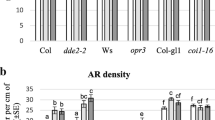Abstract.
When a brassinosteroid biosynthesis inhibitor, brassinazole (Brz), was applied at concentrations ranging from 0.1 to 2 μM, Arabidopsis thaliana (L.) Heynh seedlings grown in the dark exhibited morphological features of light-grown plants, i.e. short hypocotyls, expanded cotyledons, and true leaves, in a dose-dependent manner. Control (non Brz-treated) seedlings grown in the dark for 40 d did not develop leaf primordia. However, treatment with the lowest concentration of Brz induced the development of leaf buds, although it hardly induced any short hypocotyls, and treatment with the highest concentration of Brz induced both short hypocotyls and leaves. Labeling experiments with the thymidine analogue 5-bromo-2′-deoxyuridine revealed that amplification of cell nuclei and organellar nucleoids is activated in the shoot apical meristems of dark-grown Brz-treated seedlings. These results suggest that Brz-treatment induces development of true leaves. Furthermore, condensation and scattering of plastid nucleoids, which is known to occur during the differentiation of etioplasts into chloroplasts, was observed in the plastids of dark-grown Brz-treated cotyledons. In addition, high levels of ribulose-1,5-bisphosphate carboxylase-oxygenase proteins accumulated in the plastids of the cotyledons. Electron microscopy showed that the plastids were etioplasts with a prolamellar body and few thylakoid membranes. These results suggest that Brz treatment in the dark induces the initial steps of plastid differentiation, which occur prior to the development of thylakoid membranes. This is a novel presumed function of brassinosteroids. These cytological changes seen in Brz-treated Arabidopsis were exactly the same as those seen in a brassinosteroid-biosynthesis-deficient mutant, det2, supporting the hypothesis that Brz has no side-effects except inhibiting brassinosteroid biosynthesis, and should prove a useful tool in clarifying the role of brassinosteroids.
Similar content being viewed by others
Author information
Authors and Affiliations
Additional information
Received: 10 February 2000 / Accepted: 11 April 2000
Rights and permissions
About this article
Cite this article
Nagata, N., Min, Y., Nakano, T. et al. Treatment of dark-grown Arabidopsis thaliana with a brassinosteroid-biosynthesis inhibitor, brassinazole, induces some characteristics of light-grown plants. Planta 211, 781–790 (2000). https://doi.org/10.1007/s004250000351
Issue Date:
DOI: https://doi.org/10.1007/s004250000351




